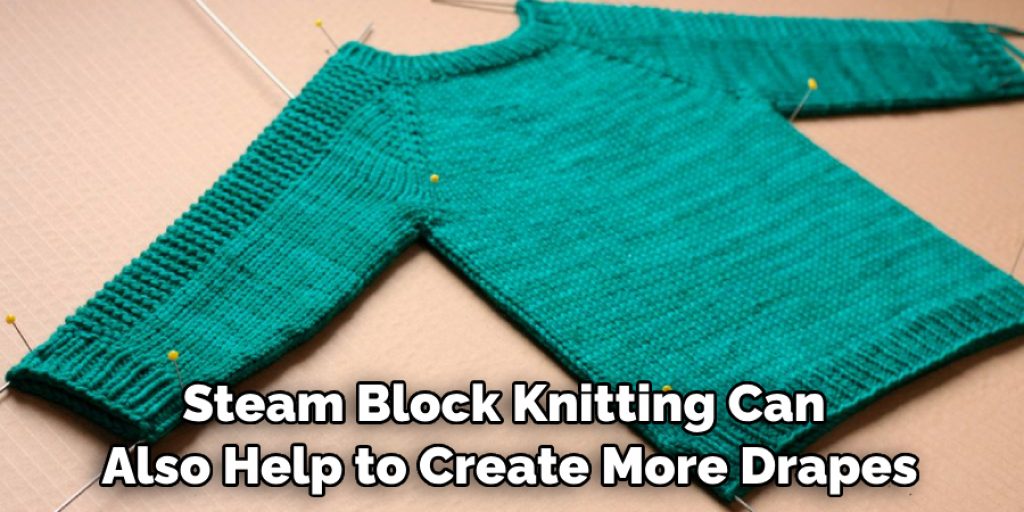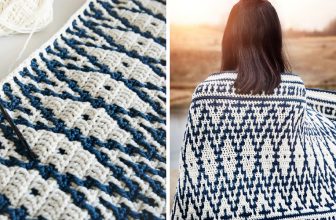How to Steam Block Knitting
Every knitter knows that blocking is one of the fundamental steps in completing a knitted project. But did you know that there are different methods of blocking and that steaming is one of the most effective ways to achieve a smooth and even finish?

Steaming can soften the fibers, encourage them to settle into shape, and add a professional-looking finish to your work. In this blog post, we’ll be discussing how to steam block knitting, so you can get the perfect result every time.
Can You Steam Block Knitting?
Many knitters debate whether or not steam blocking is a suitable option for their beloved projects. Some experts advise against it, citing concerns about unintentionally stretching the delicate fibers or damaging the overall appearance of the knit. However, others argue that steam blocking can be a valuable technique when used correctly, helping to create a consistent look throughout the piece and ensuring the final product is both stunning and functional.
Ultimately, the decision of whether or not to steam block knitting should be made on a case-by-case basis, taking into consideration the specific type of yarn, the desired outcome, and the skill level of the individual doing the blocking. With careful planning and attention to detail, steam blocking can be a useful tool for any knitter looking to take their work to the next level.
Why Should You Steam Block Knitting?
Knitting is an enjoyable and rewarding hobby that has been around for centuries. Whether you’re knitting socks or a sweater, it’s essential to steam block your finished project. Steam blocking involves the use of steam to shape and set your knitwear.
By doing this, you can achieve a more professional and refined finish that will make your knitting look stunning. Not only that, but steam blocking also helps to even out any inconsistencies in your knitting, ensuring that your piece looks neat.
Additionally, it can help your project to retain its shape and prevent it from stretching over time. So, if you want to take your knitting to the next level, do yourself a favor and invest in a good steam-blocking kit. Trust us, your knitwear will thank you for it!
How To Steam Block Knitting: A Step-by-Step Guide
1. Prepare Your Knitted Piece
Before steaming your knitted work, ensure it is clean and free from dirt or debris. Give it a gentle hand wash and hang it up to dry, taking care not to stretch it out of shape. Once dry, lay it flat on a towel and press out any excess water. Prepare your iron and steaming equipment (such as a handheld steamer).
2. Set the Temperature on Your Equipment
Check the recommended temperature for your type of yarn and any embellishments or trims on the fabric. Typically, synthetic yarns and blends can be steamed at a higher temperature than natural fibers such as wool and silk. Set your iron or steamer to the appropriate temperature, and remember to test it on a small, inconspicuous area first.
3. Steam Your Work Methodically

Start by placing a towel or cloth over your knitted piece. Hold the iron or steamer horizontally and hover it above the fabric, gradually moving it downwards until it comes into contact with the damp towel. This ensures that the heat is evenly distributed and the fabric is not scorched. Gently glide the iron or steamer across the fabric, working your way from one side of the piece to the other. Avoid pressing too hard, which can cause the fibers to stretch out of shape.
4. Shape Your Knitted Work
As you steam, you’ll notice that the fibers begin to relax and settle into shape. Adjust any pins or blocking wires to ensure that your work is aligned and symmetrical. Use a measuring tape or ruler to ensure the dimensions are consistent and accurate. You can also drape the damp fabric over a foam block or mannequin, adjusting the shape and fit as required.
5. Allow Your Knitted Piece to Dry
Once you’ve finished steaming and shaping your work, please leave it to air dry completely. Don’t be tempted to speed up the process using a hairdryer or fan, as this can cause the fibers to become tense and lose shape. Because the steaming process relaxes the fibers, it’s important to let them dry without tension or pressure.
6. Take Care of Your Iron or Steamer
Once you’ve finished steaming, follow the manufacturer’s instructions for cleaning and maintenance. This will help keep your equipment in good working order so that it can be used again.
7. Enjoy Your Finished Work
Most importantly, enjoy your steamed knitting project! Admire your work’s neat and even shape, knowing that you’ve perfected the art of steam blocking. With a little patience and practice, you’ll soon become an expert in producing beautifully finished pieces every time. Now it’s time to show off your hard work to the world. Have fun!
That’s it! You’ve now learned how to steam block knitting projects. Congratulations! With a few simple steps, you can now take your knitted creations to the next level and produce beautiful finished pieces that look professionally done. Now go out there and show off what you can do!

5 Considerations Things When You Need to Steam Block Knitting
1. The Right Tools
When you are steam-blocking your knitting, you will need to have the right tools. This includes a steam iron, a pressing cloth, and something to protect your work surface from the heat of the iron.
2. The Right Yarn
Not all yarns can be steam blocked. For example, wool yarns not treated with a superwash finish will shrink when exposed to heat and moisture. Therefore, it is important to check the care instructions for your yarn before you begin steam blocking.
3. The Right Temperature
The temperature of your iron is also important when steam blocking. If the temperature is too high, you risk damaging your yarn or burning your work. If the temperature is too low, the steam will not be effective. Therefore, it is important to find the right balance.
4. The Right Technique
There are a few different techniques that you can use when steam-blocking your knitting. The best technique for you will depend on the type of yarn you are using and the results you hope to achieve.
5. The Right Time
Steam blocking is not something that should be done in a hurry. You will need to allow enough time for the steam to penetrate the fibers of your knitting and for the piece to cool completely before moving it or wearing it.
5 Benefits of Steam Block Knitting
1. More Even Tension
One of the benefits of steam block knitting is that it can help to create more even tension in your knitting. When you knit with steam, the heat helps to relax the fibers of your yarn, making it easier to achieve even tension. This can be especially helpful if you are a beginner knitter or working with a difficult yarn.
2. Better Stitch Definition
Another benefit of steam block knitting is that it can help to create a better stitch definition. When you steam block your knitting, the heat helps set the stitches in place, making them look neater and more defined.
3. More Drape
Steam block knitting can also help to create more drapes in your finished project. The heat from the steam helps soften the fibers of your yarn, making your knitting feel lighter and more fluid. This is a great option if you want a garment that will drape nicely on the body.

4. Greater Elasticity
Another benefit of steam block knitting is that it can help to create greater elasticity in your finished project. The heat from the steam helps to relax your yarn’s fibers, making them more elastic and less likely to break. This is a great option if you are looking for a garment with some stretch.
5. Softer Hand Feel
Finally, steam block knitting can also help to create a softer hand feel in your finished project. The heat from the steam helps to soften the fibers of your yarn, which makes them more pleasant to touch. This is a great option if you are looking for a garment that will be comfortable to wear next to your skin.
Some Common Mistakes People Make When Trying to Steam Block Knitting
Steaming is an essential step in the blocking process of knitted garments. However, people make common mistakes when trying to steam block their knitting. One of the most common errors is using an iron instead of a steamer. This mistake can damage the knitting or even melt it entirely. Another mistake is using too much pressure during the steaming process.
It is important to remember that knitting is delicate and should be treated with care. Additionally, not allowing enough time for the garment to dry before removing it from the blocking board can ruin all the hard work put into creating the piece. To avoid these mistakes, following the correct instructions and taking the time needed to steam block knitting properly is crucial.

Conclusion
Steaming is a great method for blocking knitted projects, as it’s gentle on the fabric and produces a smooth, professional-looking finish. By preparing your work, setting the right temperature, and steaming methodically, you can achieve stunning results that will make your knitting stand out. Remember to take things slow, work carefully, and allow your work to dry naturally for the best outcome. Thanks for reading our post about how to steam block knitting.




